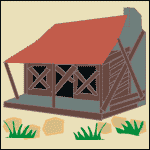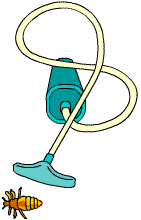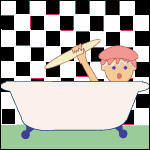Insects' Houses of the UK Shared By Humans
Created | Updated Nov 4, 2002
Insects have always had close association with humans. In fact prior to the evolution of Homo sapiens a number of insect species must have already developed an intimate relationship with Man's ancestors, possible candidates for this honour being the parasitic mosquito prevalent then as it is today in swampy habitats and the 'so-called' Human Flea which, even today is still primerily a parasite of hole and cave dwelling animals such as foxes and badgers.
The co-habitation of insects and humans dates at least back to when our ancestors evolved from tree-dwellers to the lakeside, savannah or cave. In addition to those insects already indigenous to the damp recesses of caves others would have arrived as a result of human occupation. Elsewhere the construction of temporary shelters and camps, the collection of wood for fires, food and animal hides would have provided many opportunities for insects to unintentionally share the habitat with those early humans. Certain insect species having become specially adapted to living with early man will have evolved into distinct species. The domestication of animals will have added other opportunities for insects to become associated with Man.

As early Hominids began to build simple dwellings insects would have found many opportunities to seek shelter and food within warm and dark surroundings. From that time until the present day humans have used natural materials to construct and adorn their houses and even the advent of non-organic materials has not precluded the invasion by insects into modern houses. Often the co-existence of other animals in the house, invited or otherwise, bring insects with them. Examples of such animals include birds nesting, bat roosts, rats, mice as well as a range of domestic pets. The inclusion of house plants has added further opportunities for insects to enjoy the creature comforts of modern living. In turn the presence of insects has provided incentives for other opportunistic Arthropods to set up home alongside us humans.
A survey of the Insect family reveals how varied this association is. Taking a tour of the inside of the typical house in the UK could bring one into contact with many examples of the different orders of insect.
We shall start our tour in the Kitchen.
Kitchen

The Kitchen is a rich habitat for insects. Most of us will have seen the Silverfish (Lepisma saccharina). Upto two centimetres long the unmistakeable armour-plated shiny scales, tapered form and with long bristle-like antenna, it can be spotted disappearing as we open cupboards late at night. This is a primitive insect which would have definitely inhabited those caves of early Man. Typically these feed on scraps of paper, glue, spilled food. A close relative, the Firebrat (Thermobia domestica) as the name suggests enjoys the warm surroundings where bread is baked, feeding on flour.
If unlucky we may encounter the Cockroach (Blatta orientalis). These are relatively large, carnivorous insects reddish brown in colour. The German Cockroach (Blattella germanica) is much smaller and yellow-brown can also fly. Both reside during the day under floorboards and cracks in the wall emerging at night to consume unprotected meat. Their presence in large numbers and the characteristic smell creates a natural antipathy from humans. They readily carry disease so there appearance in commercial kitchens results in understandable panic. It is also not unknown for the Cockroach's larger American cousin (Periplaneta americana) to take up residence, possibly as a refugee from a terrarium.
The Black Garden Ant (Lasius niger) is the only native Ant that make expeditions into houses foraging for sugar-based foodstuffs as the colony rapidly expands in early Summer. The Pharaoh’s Ant (Monomorium pharaonis) yellow in colour and the Argentine Ant (Iridomyrmex humilis) of a blackish hue are both smaller than the other native ants and have been introduced from the tropics. Very much a civilising influence in the Ant world, they can only be found inhabiting warm buildings making their nests in wall crevices near to food supplies.
The Cellar

Moving downstairs to the cellar there are several small moths which inhabit food storage areas. Typical is the Flour Moth (Pyralis farnalis) the larva of which as its name suggests feeds on stored cereals as well as fruit and nuts. The moth which is more likely to be seen is a drab grey brown colour and, except to the expert entomologist, indistinguishable from many other moths.
Many beetles also invade food storage areas. Watch out for the eponymous Larder Beetle (Dermestes lardarius), its relative the Bacon Beetle (D. maculates) and the Grain Weevil (Sitophilus granaries) being good examples. The aptly named Cellar or Churchyard Beetle (Blaps mucronata) is also found in most dark places. Mainly a scavenger unless it becomes an infestation.
The Frit Fly (Oscinella frit) is only 1.5mm long. Mainly an agricultural pest but found in the Autumn in food stores where the larvae burrow into stored cereals and fruit. On the other hand the Cheese Fly (Piophila casei) is a small shiny black fly which as the name suggests enjoys a mature cheddar. Finally, the Vinegar or Fruit Fly (Drosophila melanogaster) beloved by Geneticists is attracted to anything fermenting from wine to fruit.
Unlike the other inhabitants the House Cricket (Acheta domesticus) is generally considered by those who enjoy hearing the melodious chirping as ‘mostly harmless’(to coin a phrase), although it does attack stored food. Originally a North African species it is attracted by warmth indoors in Winter to survive the unsuitable climate. The female may lay up to 1000 eggs over its lifetime and the nymphs feed on food scraps.
Living Room

Moving into the Living Room a number of insects can be found relaxing in the comfortable surroundings also well enjoyed by us humans. The Carpet Beetle (Anthrenus sp) enjoys a variety of natural fibres be it carpets, curtains or furs. Look out for the larvae which are known as ‘wholly bears’. The Woodworm or Furniture Beetle (Anobium punctatum) are one of several species of wood-boring beetle that infest wood leaving their mark in the form of neat round holes and a small pile of dust. Scurrying across the floor in the evening you might spot the Devil’s Coach Horse (Ocypus olens). A friend rather than foe for it feeds on the larvae of other insects such as flies. On warm evenings in Spring if the window is open you may be visited by the Cockchafer (Melolontha melolontha). In the late Summer another frequent intruder is the Cranefly or Daddy-long-legs (Tipula paladosa). Neither are strictly fellow inhabitants as such but are mentioned here due to its tendency to cause a stir when they bumble around the room.
No doubt every Living Room will be home from time to time to one or more of the many species of larger flies such as the Common House Fly (Musca domestica) and the Blue Bottle (Calliphora vomitoria). These insects have followed man to most parts of the world he has explored. They are considered some of the worst domestic pests on account of their capacity to carry and transfer many germs dangerous to man. Any organic material associated with man is likely to be attractive to flies. The habit of semi-digesting food by first dispersing enzymes in its saliva onto food and then sucking it up makes them particularly effective at transmitting bacteria to humans. Fly eggs are usually laid on decaying material and under warm conditions its capacity to complete its life cycle within two weeks can cause explosions in their population.
The Library

On the bookshelf one may encounter one of several members of the Booklouse family (Troctes sp). Not only is the paper attractive to these insects but the microscopic mould growing on pages of old books. Clearly these insects have evolved to exploit man-made inventions. They would have been present in houses before books appeared as they are also found in bark and this species has made the easy transition to specialise on paper.
The Bedroom
To be expected some of the insects to be found in the bedroom have more intimate relationships with humans. The Bed-Bug (Cimex lectularius) at around 6mm in length probably has one of the most ancient associations with Man. It primarily feeds on human blood. Although less common today it resides in bedding during the day and emerges to attach to humans and feed at night. It has relatives that feed exclusively on specific other mammals including household pets. To readdress the balance one should welcome the appearance of the Assassin Bug (Reuvius personatus) which may take the opportunity to feed on Bed Bugs.
Elsewhere in the Bedroom various species of moth can be found. Typical is the Common Clothes Moth (Tinola bisselliella). Inhabiting the wardrobe or carpet the caterpillar may be found feeding on fabrics of vegetable origin such as cotton as well as hair, fur and silk. Despite its more exotic name the Fur Beetle (Attagenus pellio) and the Tapestry Moth (Trichophaga tapetzella) do not limit themselves to more lavish materials and will happily go downmarket and eat out on any fabrics of animal or vegetable origin respectively.
Perhaps appropriate to mention here the Earwig (Forficula auricularia) which superstition would have it has a penchant for the human ear. True earwigs seek the warmth of houses sometimes and do like dark crevices buts that’s as far as it goes!
The Bathroom

Whilst in the Bathroom it is most appropriate to refer to hygiene matters. The Human Louse (Pediculus humanus) which comes in two forms, the Head Louse and Body Louse each remaining faithful to their particular parts of the anatomy. The Human Flea (Pulex irritans) has a long association with Man. Originally confined to foxes and badgers it adopted humans once they began to inhabit caves. The absence of proper hygiene can result in rapid infestation and consequent spread of disease through the bite of these insects. Of course other species of flea also inhabit out furniture but enjoy the delights provided by our domestic pets instead.
The Attic
Depending on what one chooses to store there the attic can be prime territory for the infesting insect. More specific to this location is the notorious but thankfully rare, Death Watch Beetle (Xestobium rufovillosum). The larvae, by tunnelling extensively through the rafters can reduce them to dust very rapidly. The name derives from the pneumatic-like ‘knocking’ of the adults as part of the mating call. Elsewhere in the attic may be a colony of the Tree Wasp (Dolichovespula sylvestris). Their nest comprises ‘paper’ produced by scrapings of wood chewed and mixed with saliva to make a pulp and applied to make their dome-shaped home.
Outside

The materials used to construct the house will dictate which insects might share one’s abode. Typically a brick built house will be visited by Mason Bees (Osmia rufa) which excavate holes in the mortar to lay their eggs in cells packed with pollen and nectar for their offspring. The Mason Wasp (Odyneurus apinipes) has a similar habit but provides the larva with a caterpillar instead. There have been reported colonies of Termites (Reticulitermes sp) attacking the damp timbers of old houses on the South Coast from time to time but the cool climate has thankfully prevented them becoming a resident pest in the UK.
Underneath the window-sills during the Winter may be found another ‘friendly’ insect, possibly hibernating singularly or in large numbers huddled together, the Seven-spot Ladybird (Coccinella 7-punctata). Other hibernating insects include several species of Butterfly including the Peacock (Inachis io) and the Small Tortoiseshell (Anglais urticae) which produce two or three generations each year. The adult butterfly emerging in the late Summer will seek a warm dry corner inside or outside the house in which to shelter for the winter.
Insects Don't Have It All Their Own Way
Ecologists will tell you that left to their own devices we could find ourselves knee-deep in flies within a matter of months of an invasion. Luckily, in addition to several carnivorous insects mentioned already elsewhere, we have to thank the resident members of several other Arthropod Classes for keeping the house in order. First the much maligned Arachnids. The House Spider (Tegenaria domestica) at up to 6cm across, dark brown and very hairy adds spice to our lives, especially when curled up on the hearth rug it makes an unannounced appearance on one of its nocturnal hunting expeditions. Another arachnid joining us temporarily in the Winter months is the Harvestman (Phalangium opilio). Up to 30mm across with its unmistakable features, very long legs and a compact body, it can be seen stalking the open prairies of the house for its insect prey.
Although close relatives of both spiders and Harvestman but very different in appearance is the ancient order of Pseudo or False Scorpions such as the House Scorpion (Chelifer cancroides). Despite being only 5mm long with a mean set of pincers resembling the true scorpions they are a match for most insects of similar size they might encounter in the environs of the skirting board. Another favourite companion of ours is the Centipede such as the long-legged variety Scutigera coleoptrata which exclusively inhabits houses. Beware, as it does not reserve its painful bite for insects alone!
So Whose House Is It Anyway?
One might believe in this age of man-made materials and chemical treatments that humans could call their house their own. However, insects will have none of that and despite human's best efforts they will only be co-habiting with insects who hopefully will in turn continue to tolerate us living alongside them.
Acknowledgement.
Gerald and Lee Durrell whose book "The Amateur Naturalist" first stimulated the idea for this Guide.
